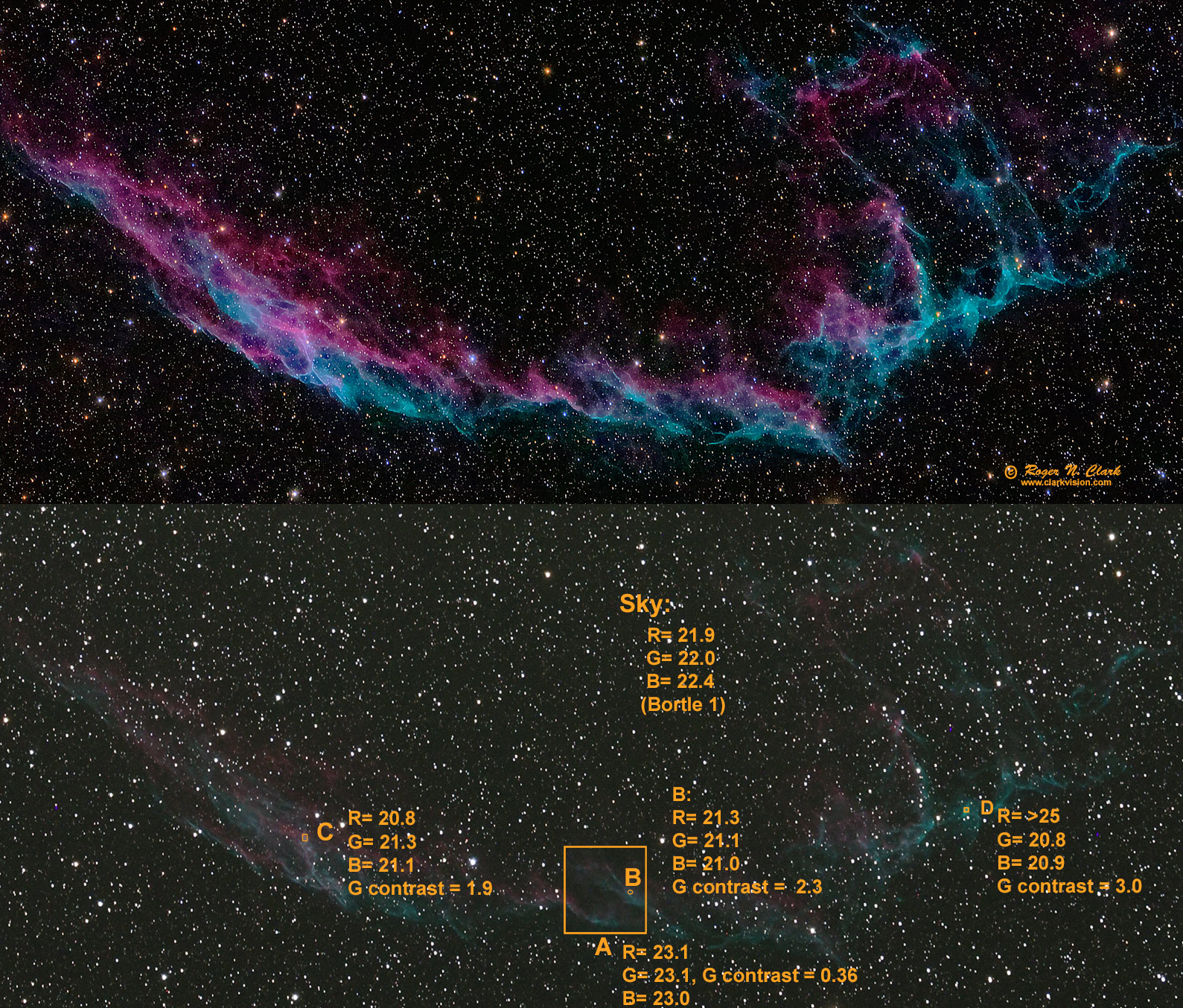| Home | Galleries | Articles | Reviews | Best Gear | New | About | Contact | Gallery Index | Previous |
Next |

| Home | Galleries | Articles | Reviews | Best Gear | New | About | Contact | Gallery Index | Previous |
Next |

The Veil nebula is a supernova remnant estimated to be 10,000 to 20,000 years old. The nebula is a beautiful sight in larger amateur telescopes (6-inch aperture and larger). Visually, it looks like smoke hanging in air and the larger the telescope, the more of the thin narrow strands of nebulae can be resolved. The image is natural color. The pink/magenta is emission from hydrogen, and the teal is emission from oxygen. Star color is close to what we would see with our eyes in telescopes: solar type stars are white, cooler stars yellow to orange and red, and stars hotter than our Sun are bluish-white.
The Veil nebula has a large range in surface brightnesses. The wisps are as narrow as 1 to 2 arc-seconds. The table below shows the contrast for the four spots indicated in the image above. Location A is the large square. If your resolution is lower than the width of the wisps, the average surface brightness is lower, like spot A in the worst case. Spots B, C, and D are bright areas, thus optimum areas for detection when resolved. When contrast is less than one, the sky is brighter than the nebula. Faint wisps have fainter surface brightness than even Bortle 1 skies (surface brightnesses of 25 magnitudes per square arc-second and fainter). As contrast decreases, Signal-to-Noise (S/N) in astrophotos decreases, and detection of details with visual observations through a telescope become more difficult. Visually, as magnification is increased, surface brightness in your eye decreases, but contrast is unchanged. See Figure 2.5 here for visual contrast thresholds as a function of surface brightness and apparent angular size. Visually optimum angular size is when the detail appears about 1 to 2 degrees across to the eye. For faint wisps that are 2 arc-seconds wide, that would be magnifications well above 1000x if at the threshold of detectiion. If brighter than the visual threshold, then lower magnifications work.
Bortle Sky Visual Contrast (G filter)
Number Surface -----------------------------------
Brightness A B C D
------------------------------------------------------
1 21.9 0.36 2.29 1.90 3.02
2 21.7 0.27 1.74 1.44 2.29
3 21.4 0.21 1.32 1.10 1.74
4 21.0 0.14 0.91 0.76 1.20
5 19.8 0.05 0.30 0.25 0.40
6 18.8 0.02 0.12 0.10 0.16
7 18.2 0.01 0.07 0.06 0.09
8 17.5 0.006 0.036 0.030 0.048
9 17.0 0.004 0.023 0.019 0.030
------------------------------------------------------
Technical. This image was obtained with a stock Canon EOS R5 Mirrorless Digital Camera and Canon 500 mm f/4 L IS lens (Newer model: Canon EF 500mm f/4L IS II USM Lens). Total exposure time was 22.5 minutes (nine 150-second exposures) at ISO 1600. This is a natural color image. Post processing: raw conversion with Photoshop ACR (normally I would use rawtherapee, but the color matrix correction in rawtherapee did not do well with the teal oxygen emission and made it too blue), stacking with deep sky stacker, Stretched with rnc-color-stretch, 3x star reduction in ImagsPlus, and final adjustments in photoshop. No darks, no flats, no bias frames (flat field is in the ACR lens profile and corrected during raw conversion). The exposures were tracked on a Losmandy G11 equatorial mount with an autoguider. Mean RMS tracking accuracy was around 0.5 arc-second, but some wind shook the camera occasionally making the stars slightly oval, seen in the full resolution image.
The lower annotated image is a single frame, 150-second exposure, out of camera jpeg, daylight white balance.
This image is a crop from the full frame. Original plate scale is 1.81 arc-seconds/pixel (7800 x 5040 pixels, 39 megapixels) and this image is shown at 2/3 resolution 2.7 arc-seconds/pixel.
This is a natural color image.
The Exposure Factors, CEF, CEFA are measures of the relative amounts of light received from a subject. It can be used to fairly compare wildly different lens/telescope apertures and exposure times. For this image on the sky:
Modern digital cameras like the Canon R5 include on sensor dark current suppression technology and low fixed pattern noise at ISOs around 800 and higher, making no need for dark frame subtraction. Modern raw converters correct for light fall-off and also correct for hot/dead/stuck pixels. This makes processing low light images easy: simply align and average.
Also see Astrophotography Image Processing Basic Work Flow.
To learn how to obtain stunning images like this, please visit my Extensive Articles on Photography .
Keywords to this image = astrophoto-1 nebula low-light digital_astro canon_r5 rnc-color-stretch
Image ID: veil-nebula-surface-brightness-4C3A9971-rotat-b+k-0.67x-s.jpg
| Home | Galleries | Articles | Reviews | Best Gear | Science | New | About | Contact |
Last updated April 02, 2025